IKEA: Management Accounting Systems, Budgeting and Financial Analysis
VerifiedAdded on 2023/06/18
|21
|5553
|87
Report
AI Summary
This report provides an in-depth analysis of IKEA's management accounting methodologies, highlighting the company's use of various systems such as inventory management, cost reporting, and price optimization. It explores the application of different costing techniques, including managerial and absorption costing, to manage costs effectively. The report also examines IKEA's planning procedures, focusing on operating, master, and capital budgets. Furthermore, it discusses how IKEA utilizes management accounting systems to address financial challenges. The analysis demonstrates how these practices contribute to informed decision-making, budgetary control, and overall financial health, ensuring optimal business performance and sustainable growth for IKEA.
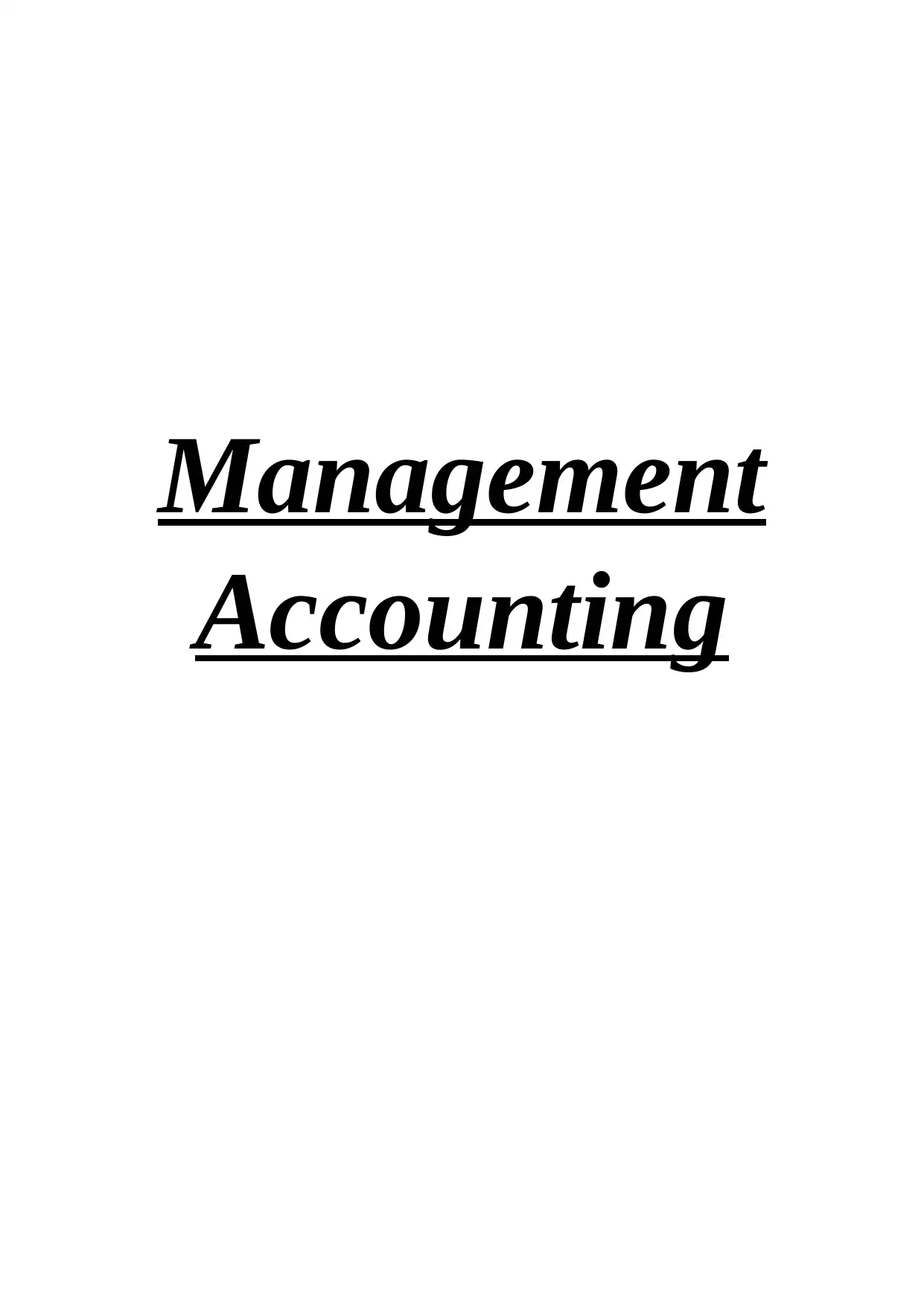
Management
Accounting
Accounting
Paraphrase This Document
Need a fresh take? Get an instant paraphrase of this document with our AI Paraphraser
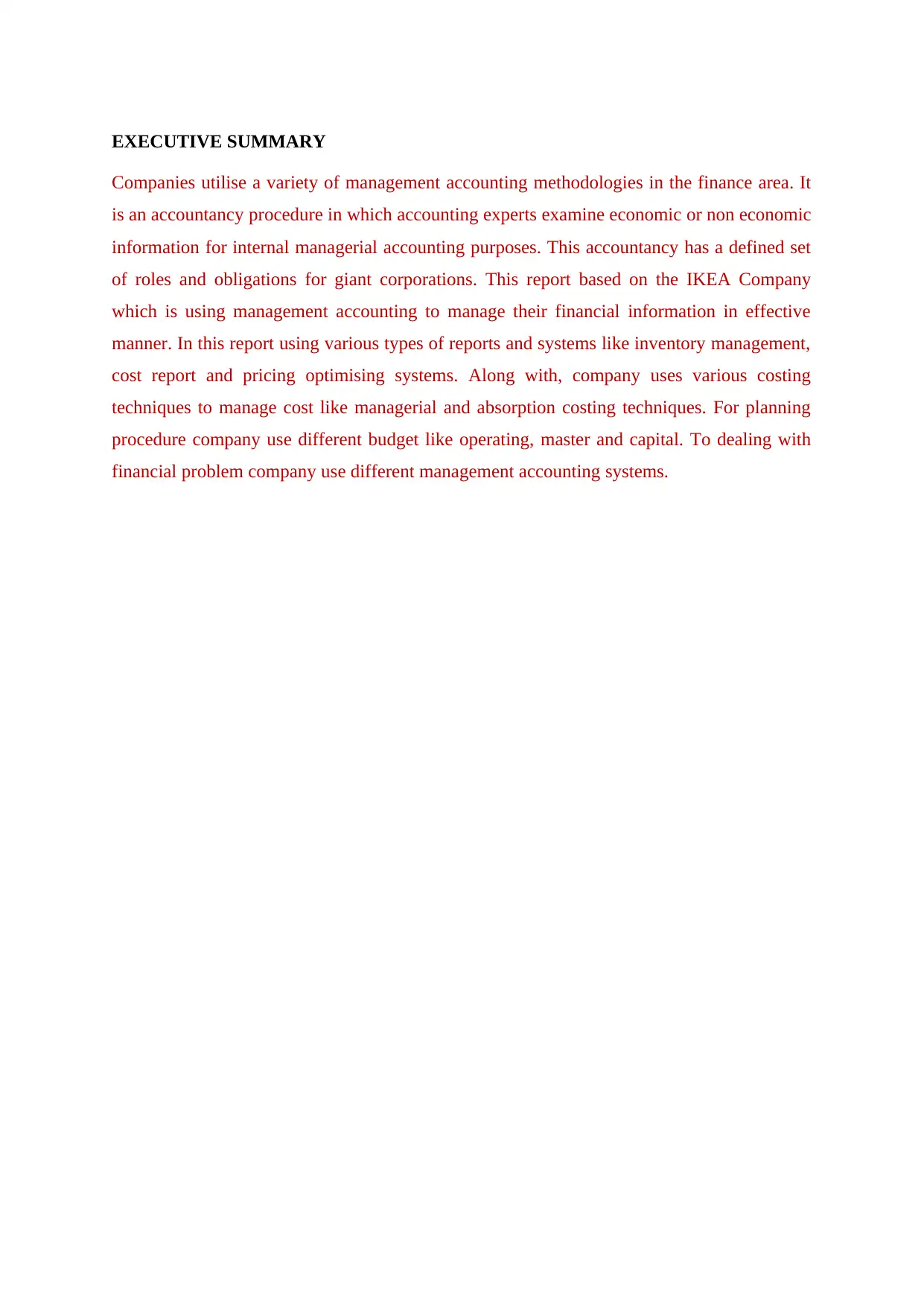
EXECUTIVE SUMMARY
Companies utilise a variety of management accounting methodologies in the finance area. It
is an accountancy procedure in which accounting experts examine economic or non economic
information for internal managerial accounting purposes. This accountancy has a defined set
of roles and obligations for giant corporations. This report based on the IKEA Company
which is using management accounting to manage their financial information in effective
manner. In this report using various types of reports and systems like inventory management,
cost report and pricing optimising systems. Along with, company uses various costing
techniques to manage cost like managerial and absorption costing techniques. For planning
procedure company use different budget like operating, master and capital. To dealing with
financial problem company use different management accounting systems.
Companies utilise a variety of management accounting methodologies in the finance area. It
is an accountancy procedure in which accounting experts examine economic or non economic
information for internal managerial accounting purposes. This accountancy has a defined set
of roles and obligations for giant corporations. This report based on the IKEA Company
which is using management accounting to manage their financial information in effective
manner. In this report using various types of reports and systems like inventory management,
cost report and pricing optimising systems. Along with, company uses various costing
techniques to manage cost like managerial and absorption costing techniques. For planning
procedure company use different budget like operating, master and capital. To dealing with
financial problem company use different management accounting systems.
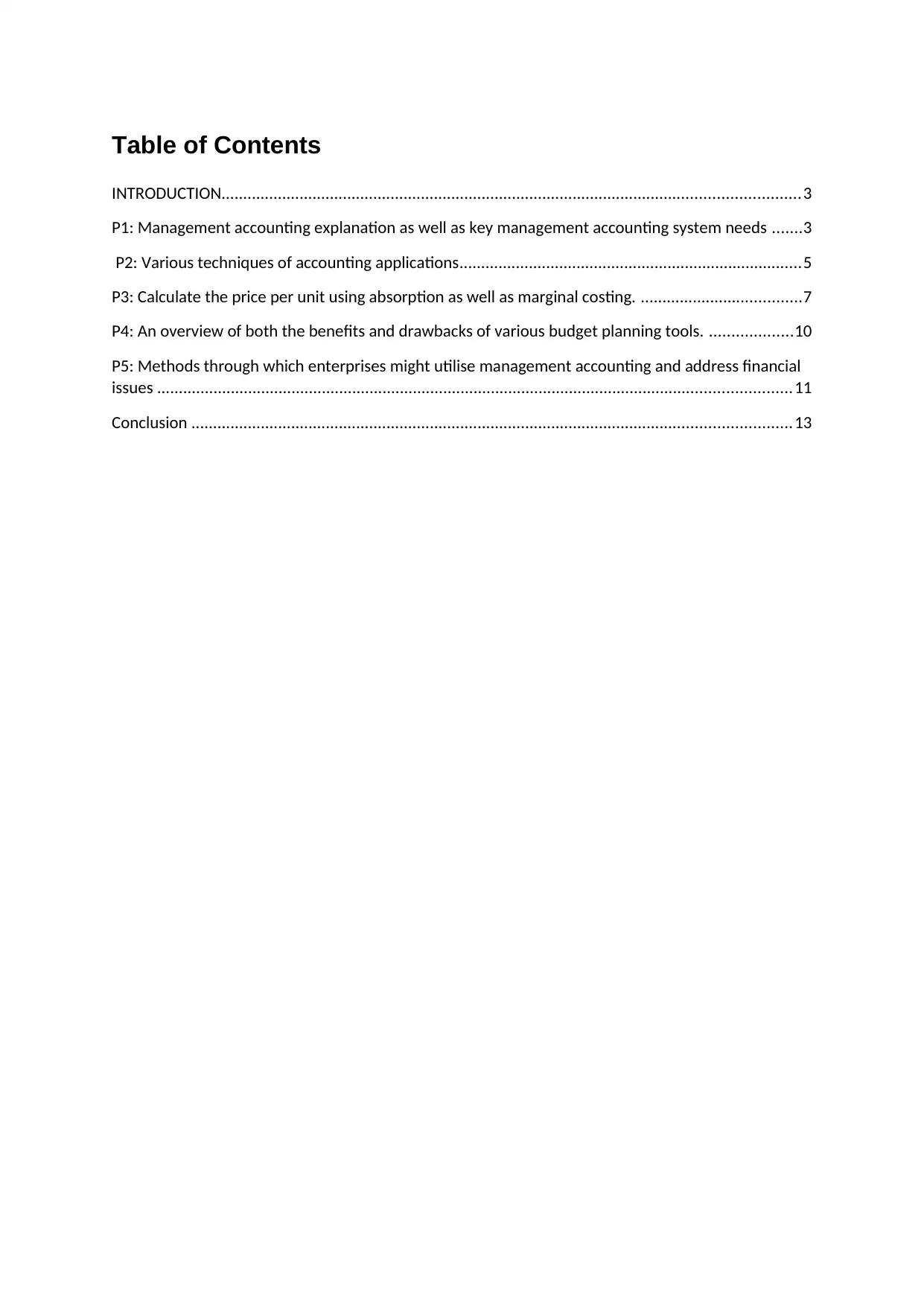
Table of Contents
INTRODUCTION.....................................................................................................................................3
P1: Management accounting explanation as well as key management accounting system needs .......3
P2: Various techniques of accounting applications...............................................................................5
P3: Calculate the price per unit using absorption as well as marginal costing. .....................................7
P4: An overview of both the benefits and drawbacks of various budget planning tools. ...................10
P5: Methods through which enterprises might utilise management accounting and address financial
issues ..................................................................................................................................................11
Conclusion ..........................................................................................................................................13
INTRODUCTION.....................................................................................................................................3
P1: Management accounting explanation as well as key management accounting system needs .......3
P2: Various techniques of accounting applications...............................................................................5
P3: Calculate the price per unit using absorption as well as marginal costing. .....................................7
P4: An overview of both the benefits and drawbacks of various budget planning tools. ...................10
P5: Methods through which enterprises might utilise management accounting and address financial
issues ..................................................................................................................................................11
Conclusion ..........................................................................................................................................13
⊘ This is a preview!⊘
Do you want full access?
Subscribe today to unlock all pages.

Trusted by 1+ million students worldwide
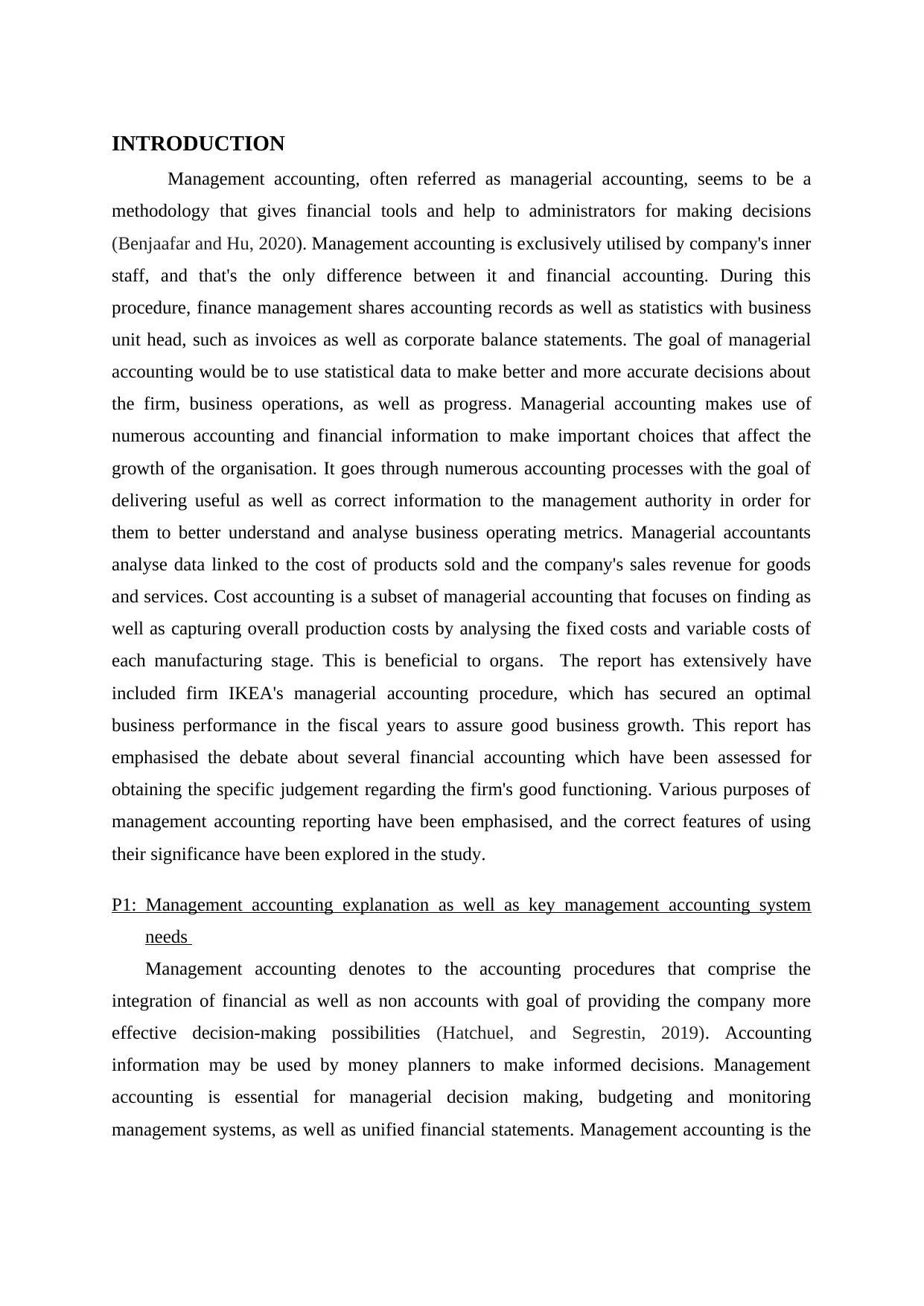
INTRODUCTION
Management accounting, often referred as managerial accounting, seems to be a
methodology that gives financial tools and help to administrators for making decisions
(Benjaafar and Hu, 2020). Management accounting is exclusively utilised by company's inner
staff, and that's the only difference between it and financial accounting. During this
procedure, finance management shares accounting records as well as statistics with business
unit head, such as invoices as well as corporate balance statements. The goal of managerial
accounting would be to use statistical data to make better and more accurate decisions about
the firm, business operations, as well as progress. Managerial accounting makes use of
numerous accounting and financial information to make important choices that affect the
growth of the organisation. It goes through numerous accounting processes with the goal of
delivering useful as well as correct information to the management authority in order for
them to better understand and analyse business operating metrics. Managerial accountants
analyse data linked to the cost of products sold and the company's sales revenue for goods
and services. Cost accounting is a subset of managerial accounting that focuses on finding as
well as capturing overall production costs by analysing the fixed costs and variable costs of
each manufacturing stage. This is beneficial to organs. The report has extensively have
included firm IKEA's managerial accounting procedure, which has secured an optimal
business performance in the fiscal years to assure good business growth. This report has
emphasised the debate about several financial accounting which have been assessed for
obtaining the specific judgement regarding the firm's good functioning. Various purposes of
management accounting reporting have been emphasised, and the correct features of using
their significance have been explored in the study.
P1: Management accounting explanation as well as key management accounting system
needs
Management accounting denotes to the accounting procedures that comprise the
integration of financial as well as non accounts with goal of providing the company more
effective decision-making possibilities (Hatchuel, and Segrestin, 2019). Accounting
information may be used by money planners to make informed decisions. Management
accounting is essential for managerial decision making, budgeting and monitoring
management systems, as well as unified financial statements. Management accounting is the
Management accounting, often referred as managerial accounting, seems to be a
methodology that gives financial tools and help to administrators for making decisions
(Benjaafar and Hu, 2020). Management accounting is exclusively utilised by company's inner
staff, and that's the only difference between it and financial accounting. During this
procedure, finance management shares accounting records as well as statistics with business
unit head, such as invoices as well as corporate balance statements. The goal of managerial
accounting would be to use statistical data to make better and more accurate decisions about
the firm, business operations, as well as progress. Managerial accounting makes use of
numerous accounting and financial information to make important choices that affect the
growth of the organisation. It goes through numerous accounting processes with the goal of
delivering useful as well as correct information to the management authority in order for
them to better understand and analyse business operating metrics. Managerial accountants
analyse data linked to the cost of products sold and the company's sales revenue for goods
and services. Cost accounting is a subset of managerial accounting that focuses on finding as
well as capturing overall production costs by analysing the fixed costs and variable costs of
each manufacturing stage. This is beneficial to organs. The report has extensively have
included firm IKEA's managerial accounting procedure, which has secured an optimal
business performance in the fiscal years to assure good business growth. This report has
emphasised the debate about several financial accounting which have been assessed for
obtaining the specific judgement regarding the firm's good functioning. Various purposes of
management accounting reporting have been emphasised, and the correct features of using
their significance have been explored in the study.
P1: Management accounting explanation as well as key management accounting system
needs
Management accounting denotes to the accounting procedures that comprise the
integration of financial as well as non accounts with goal of providing the company more
effective decision-making possibilities (Hatchuel, and Segrestin, 2019). Accounting
information may be used by money planners to make informed decisions. Management
accounting is essential for managerial decision making, budgeting and monitoring
management systems, as well as unified financial statements. Management accounting is the
Paraphrase This Document
Need a fresh take? Get an instant paraphrase of this document with our AI Paraphraser
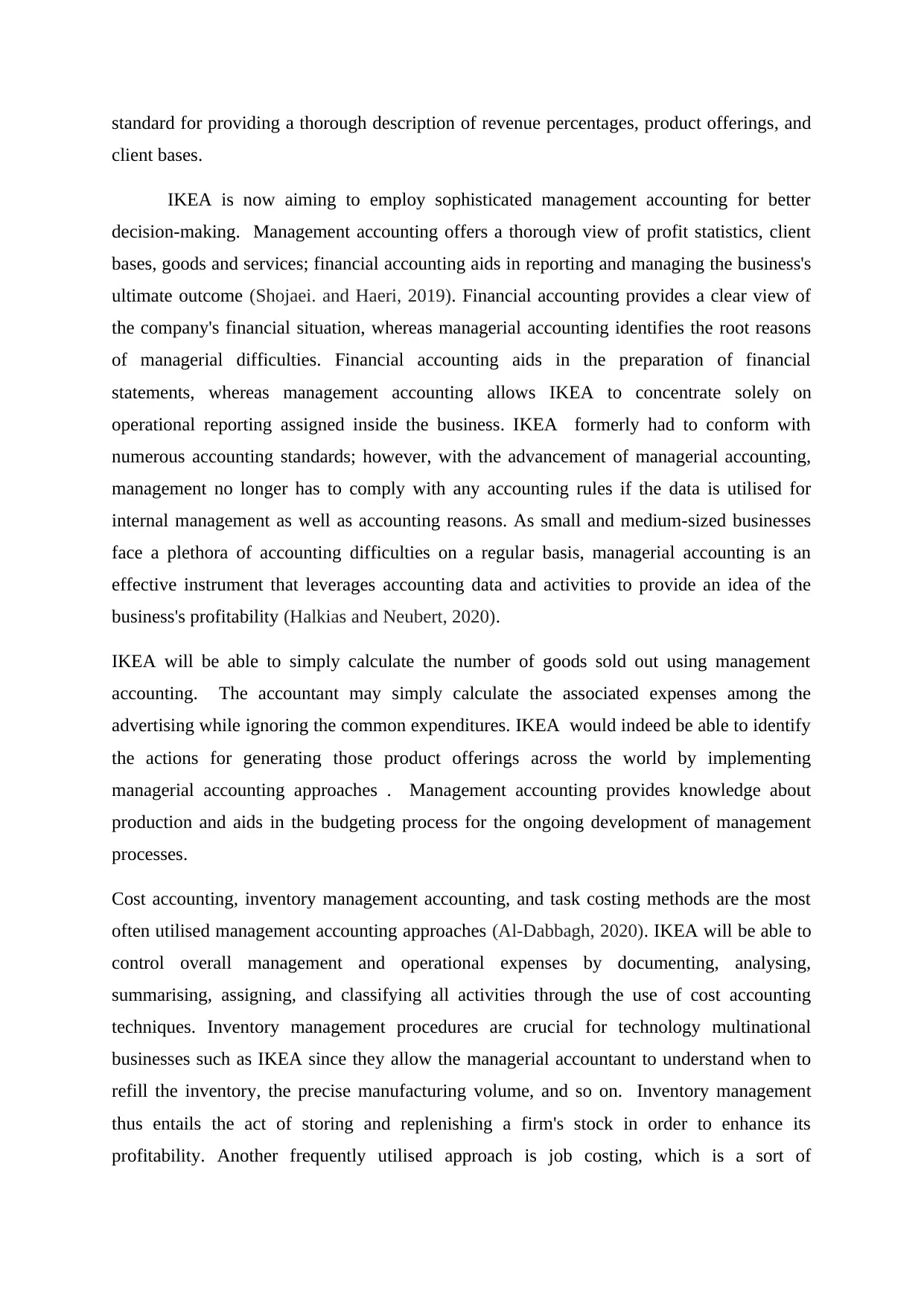
standard for providing a thorough description of revenue percentages, product offerings, and
client bases.
IKEA is now aiming to employ sophisticated management accounting for better
decision-making. Management accounting offers a thorough view of profit statistics, client
bases, goods and services; financial accounting aids in reporting and managing the business's
ultimate outcome (Shojaei. and Haeri, 2019). Financial accounting provides a clear view of
the company's financial situation, whereas managerial accounting identifies the root reasons
of managerial difficulties. Financial accounting aids in the preparation of financial
statements, whereas management accounting allows IKEA to concentrate solely on
operational reporting assigned inside the business. IKEA formerly had to conform with
numerous accounting standards; however, with the advancement of managerial accounting,
management no longer has to comply with any accounting rules if the data is utilised for
internal management as well as accounting reasons. As small and medium-sized businesses
face a plethora of accounting difficulties on a regular basis, managerial accounting is an
effective instrument that leverages accounting data and activities to provide an idea of the
business's profitability (Halkias and Neubert, 2020).
IKEA will be able to simply calculate the number of goods sold out using management
accounting. The accountant may simply calculate the associated expenses among the
advertising while ignoring the common expenditures. IKEA would indeed be able to identify
the actions for generating those product offerings across the world by implementing
managerial accounting approaches . Management accounting provides knowledge about
production and aids in the budgeting process for the ongoing development of management
processes.
Cost accounting, inventory management accounting, and task costing methods are the most
often utilised management accounting approaches (Al‐Dabbagh, 2020). IKEA will be able to
control overall management and operational expenses by documenting, analysing,
summarising, assigning, and classifying all activities through the use of cost accounting
techniques. Inventory management procedures are crucial for technology multinational
businesses such as IKEA since they allow the managerial accountant to understand when to
refill the inventory, the precise manufacturing volume, and so on. Inventory management
thus entails the act of storing and replenishing a firm's stock in order to enhance its
profitability. Another frequently utilised approach is job costing, which is a sort of
client bases.
IKEA is now aiming to employ sophisticated management accounting for better
decision-making. Management accounting offers a thorough view of profit statistics, client
bases, goods and services; financial accounting aids in reporting and managing the business's
ultimate outcome (Shojaei. and Haeri, 2019). Financial accounting provides a clear view of
the company's financial situation, whereas managerial accounting identifies the root reasons
of managerial difficulties. Financial accounting aids in the preparation of financial
statements, whereas management accounting allows IKEA to concentrate solely on
operational reporting assigned inside the business. IKEA formerly had to conform with
numerous accounting standards; however, with the advancement of managerial accounting,
management no longer has to comply with any accounting rules if the data is utilised for
internal management as well as accounting reasons. As small and medium-sized businesses
face a plethora of accounting difficulties on a regular basis, managerial accounting is an
effective instrument that leverages accounting data and activities to provide an idea of the
business's profitability (Halkias and Neubert, 2020).
IKEA will be able to simply calculate the number of goods sold out using management
accounting. The accountant may simply calculate the associated expenses among the
advertising while ignoring the common expenditures. IKEA would indeed be able to identify
the actions for generating those product offerings across the world by implementing
managerial accounting approaches . Management accounting provides knowledge about
production and aids in the budgeting process for the ongoing development of management
processes.
Cost accounting, inventory management accounting, and task costing methods are the most
often utilised management accounting approaches (Al‐Dabbagh, 2020). IKEA will be able to
control overall management and operational expenses by documenting, analysing,
summarising, assigning, and classifying all activities through the use of cost accounting
techniques. Inventory management procedures are crucial for technology multinational
businesses such as IKEA since they allow the managerial accountant to understand when to
refill the inventory, the precise manufacturing volume, and so on. Inventory management
thus entails the act of storing and replenishing a firm's stock in order to enhance its
profitability. Another frequently utilised approach is job costing, which is a sort of
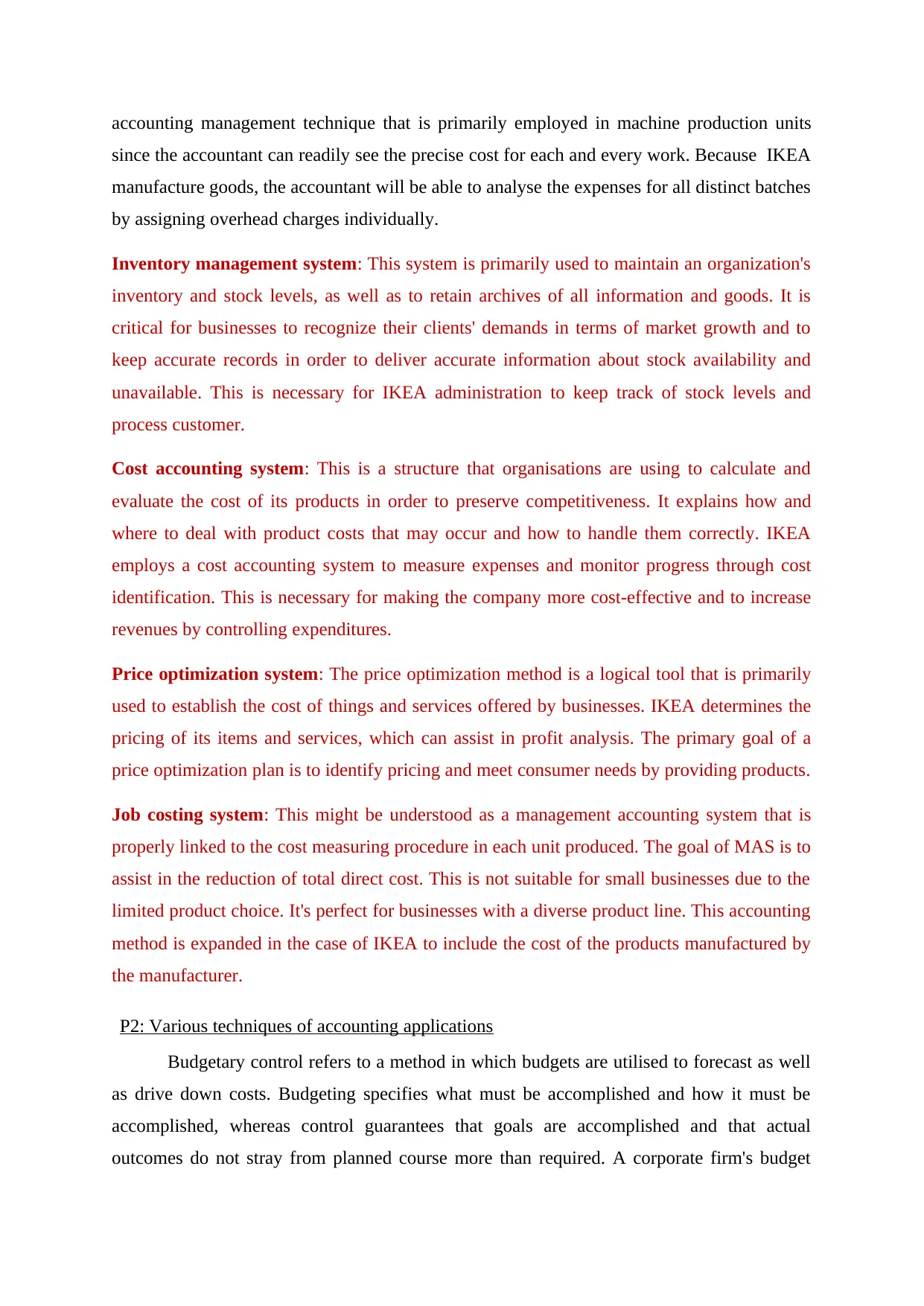
accounting management technique that is primarily employed in machine production units
since the accountant can readily see the precise cost for each and every work. Because IKEA
manufacture goods, the accountant will be able to analyse the expenses for all distinct batches
by assigning overhead charges individually.
Inventory management system: This system is primarily used to maintain an organization's
inventory and stock levels, as well as to retain archives of all information and goods. It is
critical for businesses to recognize their clients' demands in terms of market growth and to
keep accurate records in order to deliver accurate information about stock availability and
unavailable. This is necessary for IKEA administration to keep track of stock levels and
process customer.
Cost accounting system: This is a structure that organisations are using to calculate and
evaluate the cost of its products in order to preserve competitiveness. It explains how and
where to deal with product costs that may occur and how to handle them correctly. IKEA
employs a cost accounting system to measure expenses and monitor progress through cost
identification. This is necessary for making the company more cost-effective and to increase
revenues by controlling expenditures.
Price optimization system: The price optimization method is a logical tool that is primarily
used to establish the cost of things and services offered by businesses. IKEA determines the
pricing of its items and services, which can assist in profit analysis. The primary goal of a
price optimization plan is to identify pricing and meet consumer needs by providing products.
Job costing system: This might be understood as a management accounting system that is
properly linked to the cost measuring procedure in each unit produced. The goal of MAS is to
assist in the reduction of total direct cost. This is not suitable for small businesses due to the
limited product choice. It's perfect for businesses with a diverse product line. This accounting
method is expanded in the case of IKEA to include the cost of the products manufactured by
the manufacturer.
P2: Various techniques of accounting applications
Budgetary control refers to a method in which budgets are utilised to forecast as well
as drive down costs. Budgeting specifies what must be accomplished and how it must be
accomplished, whereas control guarantees that goals are accomplished and that actual
outcomes do not stray from planned course more than required. A corporate firm's budget
since the accountant can readily see the precise cost for each and every work. Because IKEA
manufacture goods, the accountant will be able to analyse the expenses for all distinct batches
by assigning overhead charges individually.
Inventory management system: This system is primarily used to maintain an organization's
inventory and stock levels, as well as to retain archives of all information and goods. It is
critical for businesses to recognize their clients' demands in terms of market growth and to
keep accurate records in order to deliver accurate information about stock availability and
unavailable. This is necessary for IKEA administration to keep track of stock levels and
process customer.
Cost accounting system: This is a structure that organisations are using to calculate and
evaluate the cost of its products in order to preserve competitiveness. It explains how and
where to deal with product costs that may occur and how to handle them correctly. IKEA
employs a cost accounting system to measure expenses and monitor progress through cost
identification. This is necessary for making the company more cost-effective and to increase
revenues by controlling expenditures.
Price optimization system: The price optimization method is a logical tool that is primarily
used to establish the cost of things and services offered by businesses. IKEA determines the
pricing of its items and services, which can assist in profit analysis. The primary goal of a
price optimization plan is to identify pricing and meet consumer needs by providing products.
Job costing system: This might be understood as a management accounting system that is
properly linked to the cost measuring procedure in each unit produced. The goal of MAS is to
assist in the reduction of total direct cost. This is not suitable for small businesses due to the
limited product choice. It's perfect for businesses with a diverse product line. This accounting
method is expanded in the case of IKEA to include the cost of the products manufactured by
the manufacturer.
P2: Various techniques of accounting applications
Budgetary control refers to a method in which budgets are utilised to forecast as well
as drive down costs. Budgeting specifies what must be accomplished and how it must be
accomplished, whereas control guarantees that goals are accomplished and that actual
outcomes do not stray from planned course more than required. A corporate firm's budget
⊘ This is a preview!⊘
Do you want full access?
Subscribe today to unlock all pages.

Trusted by 1+ million students worldwide
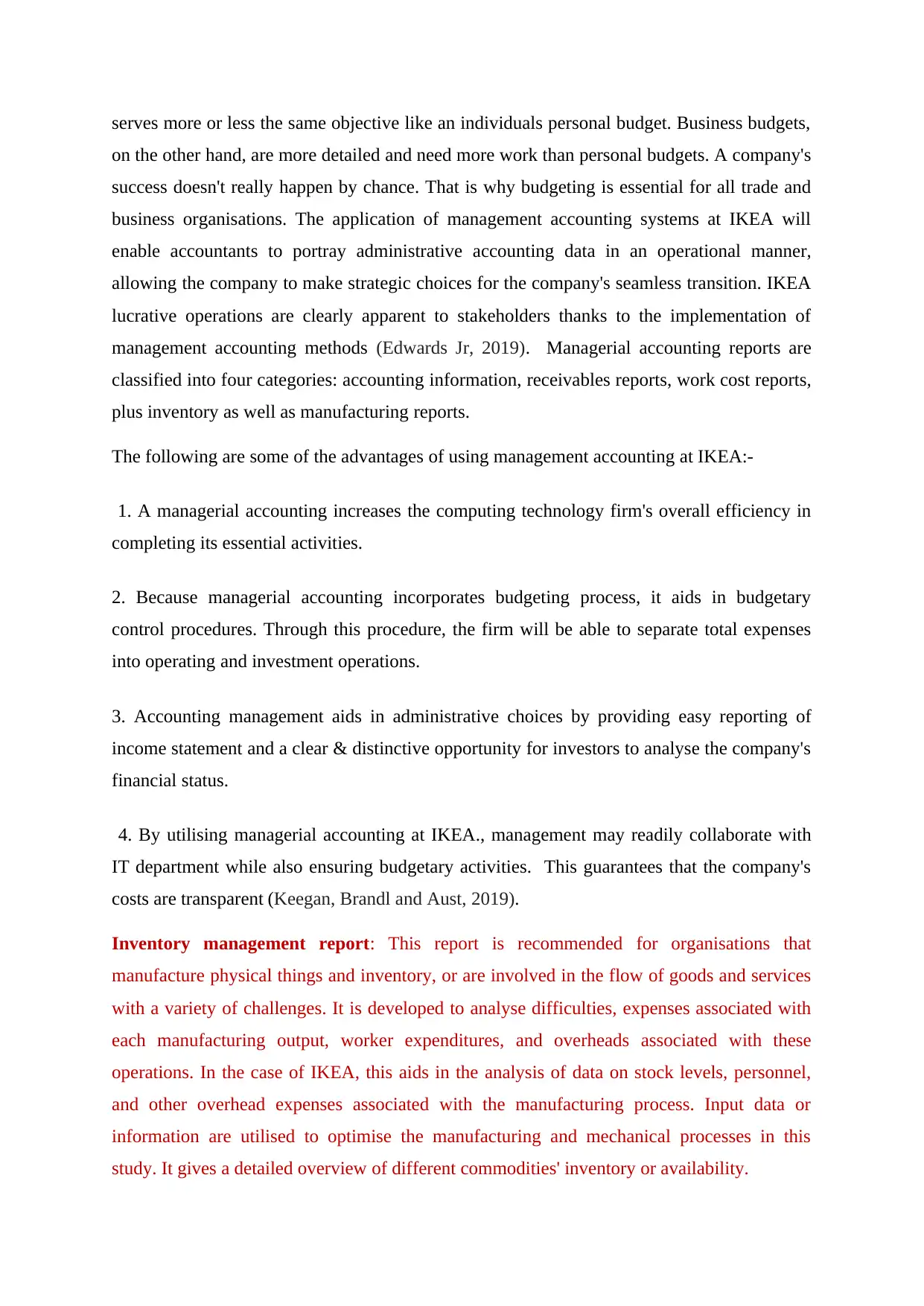
serves more or less the same objective like an individuals personal budget. Business budgets,
on the other hand, are more detailed and need more work than personal budgets. A company's
success doesn't really happen by chance. That is why budgeting is essential for all trade and
business organisations. The application of management accounting systems at IKEA will
enable accountants to portray administrative accounting data in an operational manner,
allowing the company to make strategic choices for the company's seamless transition. IKEA
lucrative operations are clearly apparent to stakeholders thanks to the implementation of
management accounting methods (Edwards Jr, 2019). Managerial accounting reports are
classified into four categories: accounting information, receivables reports, work cost reports,
plus inventory as well as manufacturing reports.
The following are some of the advantages of using management accounting at IKEA:-
1. A managerial accounting increases the computing technology firm's overall efficiency in
completing its essential activities.
2. Because managerial accounting incorporates budgeting process, it aids in budgetary
control procedures. Through this procedure, the firm will be able to separate total expenses
into operating and investment operations.
3. Accounting management aids in administrative choices by providing easy reporting of
income statement and a clear & distinctive opportunity for investors to analyse the company's
financial status.
4. By utilising managerial accounting at IKEA., management may readily collaborate with
IT department while also ensuring budgetary activities. This guarantees that the company's
costs are transparent (Keegan, Brandl and Aust, 2019).
Inventory management report: This report is recommended for organisations that
manufacture physical things and inventory, or are involved in the flow of goods and services
with a variety of challenges. It is developed to analyse difficulties, expenses associated with
each manufacturing output, worker expenditures, and overheads associated with these
operations. In the case of IKEA, this aids in the analysis of data on stock levels, personnel,
and other overhead expenses associated with the manufacturing process. Input data or
information are utilised to optimise the manufacturing and mechanical processes in this
study. It gives a detailed overview of different commodities' inventory or availability.
on the other hand, are more detailed and need more work than personal budgets. A company's
success doesn't really happen by chance. That is why budgeting is essential for all trade and
business organisations. The application of management accounting systems at IKEA will
enable accountants to portray administrative accounting data in an operational manner,
allowing the company to make strategic choices for the company's seamless transition. IKEA
lucrative operations are clearly apparent to stakeholders thanks to the implementation of
management accounting methods (Edwards Jr, 2019). Managerial accounting reports are
classified into four categories: accounting information, receivables reports, work cost reports,
plus inventory as well as manufacturing reports.
The following are some of the advantages of using management accounting at IKEA:-
1. A managerial accounting increases the computing technology firm's overall efficiency in
completing its essential activities.
2. Because managerial accounting incorporates budgeting process, it aids in budgetary
control procedures. Through this procedure, the firm will be able to separate total expenses
into operating and investment operations.
3. Accounting management aids in administrative choices by providing easy reporting of
income statement and a clear & distinctive opportunity for investors to analyse the company's
financial status.
4. By utilising managerial accounting at IKEA., management may readily collaborate with
IT department while also ensuring budgetary activities. This guarantees that the company's
costs are transparent (Keegan, Brandl and Aust, 2019).
Inventory management report: This report is recommended for organisations that
manufacture physical things and inventory, or are involved in the flow of goods and services
with a variety of challenges. It is developed to analyse difficulties, expenses associated with
each manufacturing output, worker expenditures, and overheads associated with these
operations. In the case of IKEA, this aids in the analysis of data on stock levels, personnel,
and other overhead expenses associated with the manufacturing process. Input data or
information are utilised to optimise the manufacturing and mechanical processes in this
study. It gives a detailed overview of different commodities' inventory or availability.
Paraphrase This Document
Need a fresh take? Get an instant paraphrase of this document with our AI Paraphraser
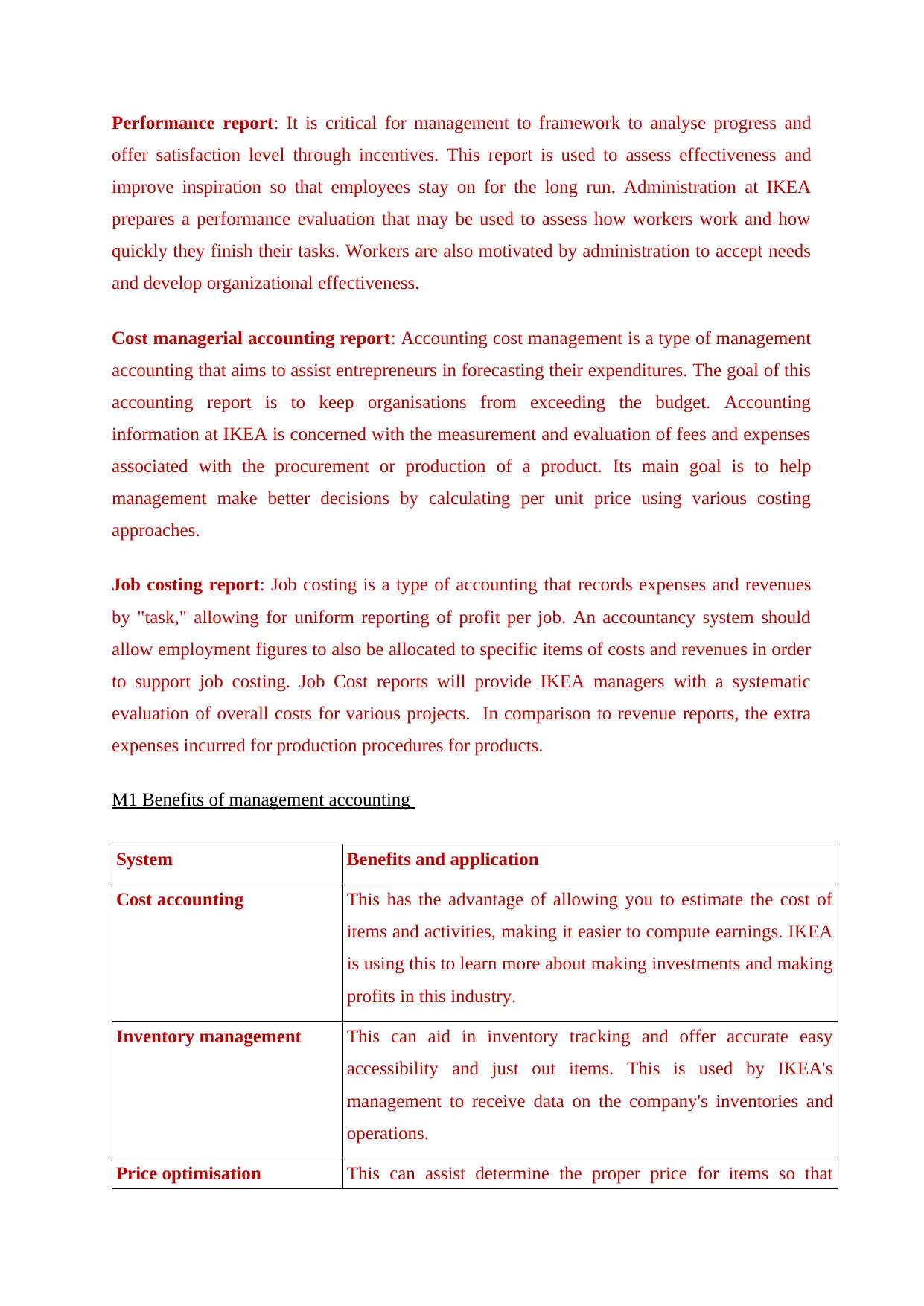
Performance report: It is critical for management to framework to analyse progress and
offer satisfaction level through incentives. This report is used to assess effectiveness and
improve inspiration so that employees stay on for the long run. Administration at IKEA
prepares a performance evaluation that may be used to assess how workers work and how
quickly they finish their tasks. Workers are also motivated by administration to accept needs
and develop organizational effectiveness.
Cost managerial accounting report: Accounting cost management is a type of management
accounting that aims to assist entrepreneurs in forecasting their expenditures. The goal of this
accounting report is to keep organisations from exceeding the budget. Accounting
information at IKEA is concerned with the measurement and evaluation of fees and expenses
associated with the procurement or production of a product. Its main goal is to help
management make better decisions by calculating per unit price using various costing
approaches.
Job costing report: Job costing is a type of accounting that records expenses and revenues
by "task," allowing for uniform reporting of profit per job. An accountancy system should
allow employment figures to also be allocated to specific items of costs and revenues in order
to support job costing. Job Cost reports will provide IKEA managers with a systematic
evaluation of overall costs for various projects. In comparison to revenue reports, the extra
expenses incurred for production procedures for products.
M1 Benefits of management accounting
System Benefits and application
Cost accounting This has the advantage of allowing you to estimate the cost of
items and activities, making it easier to compute earnings. IKEA
is using this to learn more about making investments and making
profits in this industry.
Inventory management This can aid in inventory tracking and offer accurate easy
accessibility and just out items. This is used by IKEA's
management to receive data on the company's inventories and
operations.
Price optimisation This can assist determine the proper price for items so that
offer satisfaction level through incentives. This report is used to assess effectiveness and
improve inspiration so that employees stay on for the long run. Administration at IKEA
prepares a performance evaluation that may be used to assess how workers work and how
quickly they finish their tasks. Workers are also motivated by administration to accept needs
and develop organizational effectiveness.
Cost managerial accounting report: Accounting cost management is a type of management
accounting that aims to assist entrepreneurs in forecasting their expenditures. The goal of this
accounting report is to keep organisations from exceeding the budget. Accounting
information at IKEA is concerned with the measurement and evaluation of fees and expenses
associated with the procurement or production of a product. Its main goal is to help
management make better decisions by calculating per unit price using various costing
approaches.
Job costing report: Job costing is a type of accounting that records expenses and revenues
by "task," allowing for uniform reporting of profit per job. An accountancy system should
allow employment figures to also be allocated to specific items of costs and revenues in order
to support job costing. Job Cost reports will provide IKEA managers with a systematic
evaluation of overall costs for various projects. In comparison to revenue reports, the extra
expenses incurred for production procedures for products.
M1 Benefits of management accounting
System Benefits and application
Cost accounting This has the advantage of allowing you to estimate the cost of
items and activities, making it easier to compute earnings. IKEA
is using this to learn more about making investments and making
profits in this industry.
Inventory management This can aid in inventory tracking and offer accurate easy
accessibility and just out items. This is used by IKEA's
management to receive data on the company's inventories and
operations.
Price optimisation This can assist determine the proper price for items so that
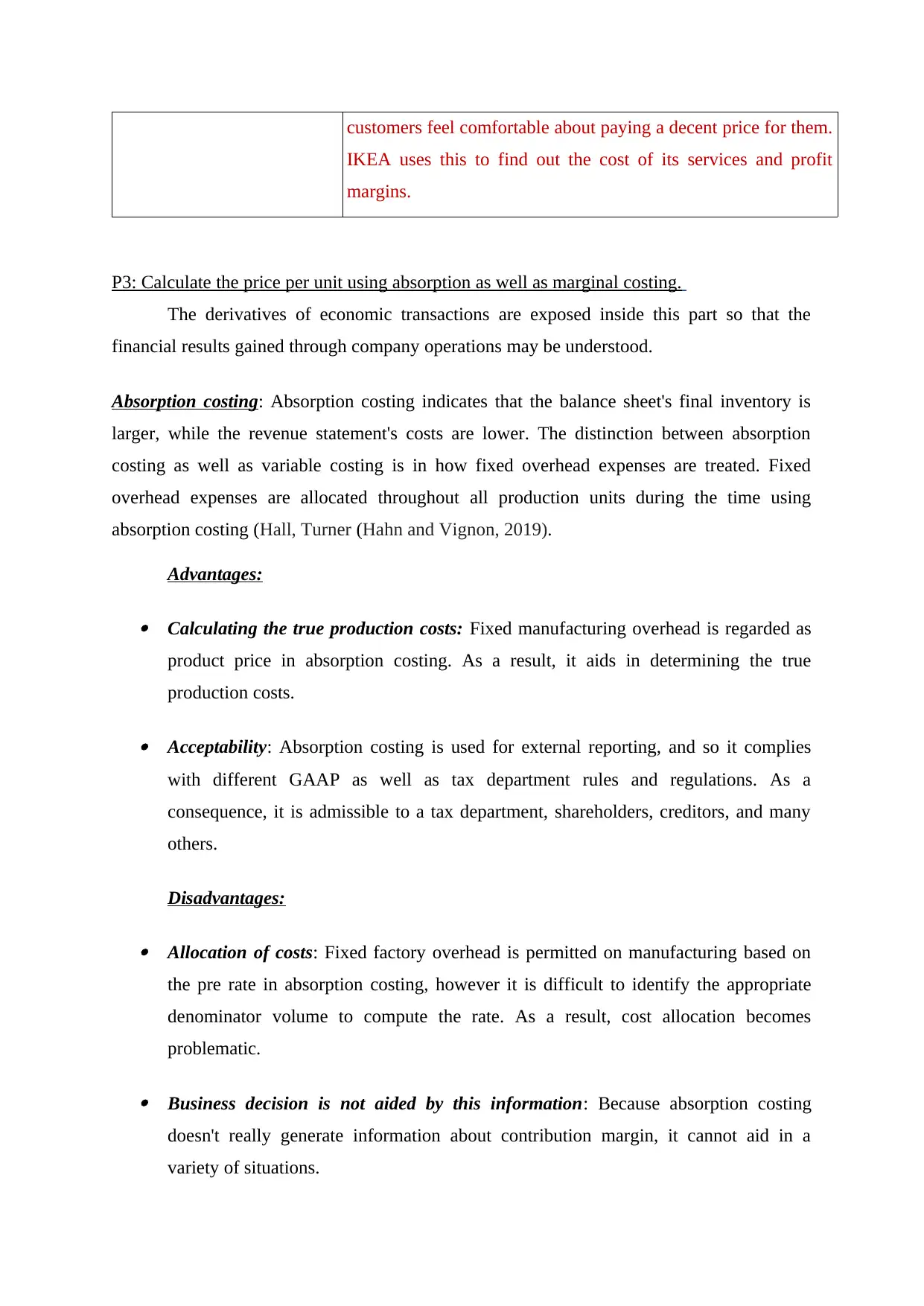
customers feel comfortable about paying a decent price for them.
IKEA uses this to find out the cost of its services and profit
margins.
P3: Calculate the price per unit using absorption as well as marginal costing.
The derivatives of economic transactions are exposed inside this part so that the
financial results gained through company operations may be understood.
Absorption costing: Absorption costing indicates that the balance sheet's final inventory is
larger, while the revenue statement's costs are lower. The distinction between absorption
costing as well as variable costing is in how fixed overhead expenses are treated. Fixed
overhead expenses are allocated throughout all production units during the time using
absorption costing (Hall, Turner (Hahn and Vignon, 2019).
Advantages:
Calculating the true production costs: Fixed manufacturing overhead is regarded as
product price in absorption costing. As a result, it aids in determining the true
production costs.
Acceptability: Absorption costing is used for external reporting, and so it complies
with different GAAP as well as tax department rules and regulations. As a
consequence, it is admissible to a tax department, shareholders, creditors, and many
others.
Disadvantages:
Allocation of costs: Fixed factory overhead is permitted on manufacturing based on
the pre rate in absorption costing, however it is difficult to identify the appropriate
denominator volume to compute the rate. As a result, cost allocation becomes
problematic.
Business decision is not aided by this information: Because absorption costing
doesn't really generate information about contribution margin, it cannot aid in a
variety of situations.
IKEA uses this to find out the cost of its services and profit
margins.
P3: Calculate the price per unit using absorption as well as marginal costing.
The derivatives of economic transactions are exposed inside this part so that the
financial results gained through company operations may be understood.
Absorption costing: Absorption costing indicates that the balance sheet's final inventory is
larger, while the revenue statement's costs are lower. The distinction between absorption
costing as well as variable costing is in how fixed overhead expenses are treated. Fixed
overhead expenses are allocated throughout all production units during the time using
absorption costing (Hall, Turner (Hahn and Vignon, 2019).
Advantages:
Calculating the true production costs: Fixed manufacturing overhead is regarded as
product price in absorption costing. As a result, it aids in determining the true
production costs.
Acceptability: Absorption costing is used for external reporting, and so it complies
with different GAAP as well as tax department rules and regulations. As a
consequence, it is admissible to a tax department, shareholders, creditors, and many
others.
Disadvantages:
Allocation of costs: Fixed factory overhead is permitted on manufacturing based on
the pre rate in absorption costing, however it is difficult to identify the appropriate
denominator volume to compute the rate. As a result, cost allocation becomes
problematic.
Business decision is not aided by this information: Because absorption costing
doesn't really generate information about contribution margin, it cannot aid in a
variety of situations.
⊘ This is a preview!⊘
Do you want full access?
Subscribe today to unlock all pages.

Trusted by 1+ million students worldwide
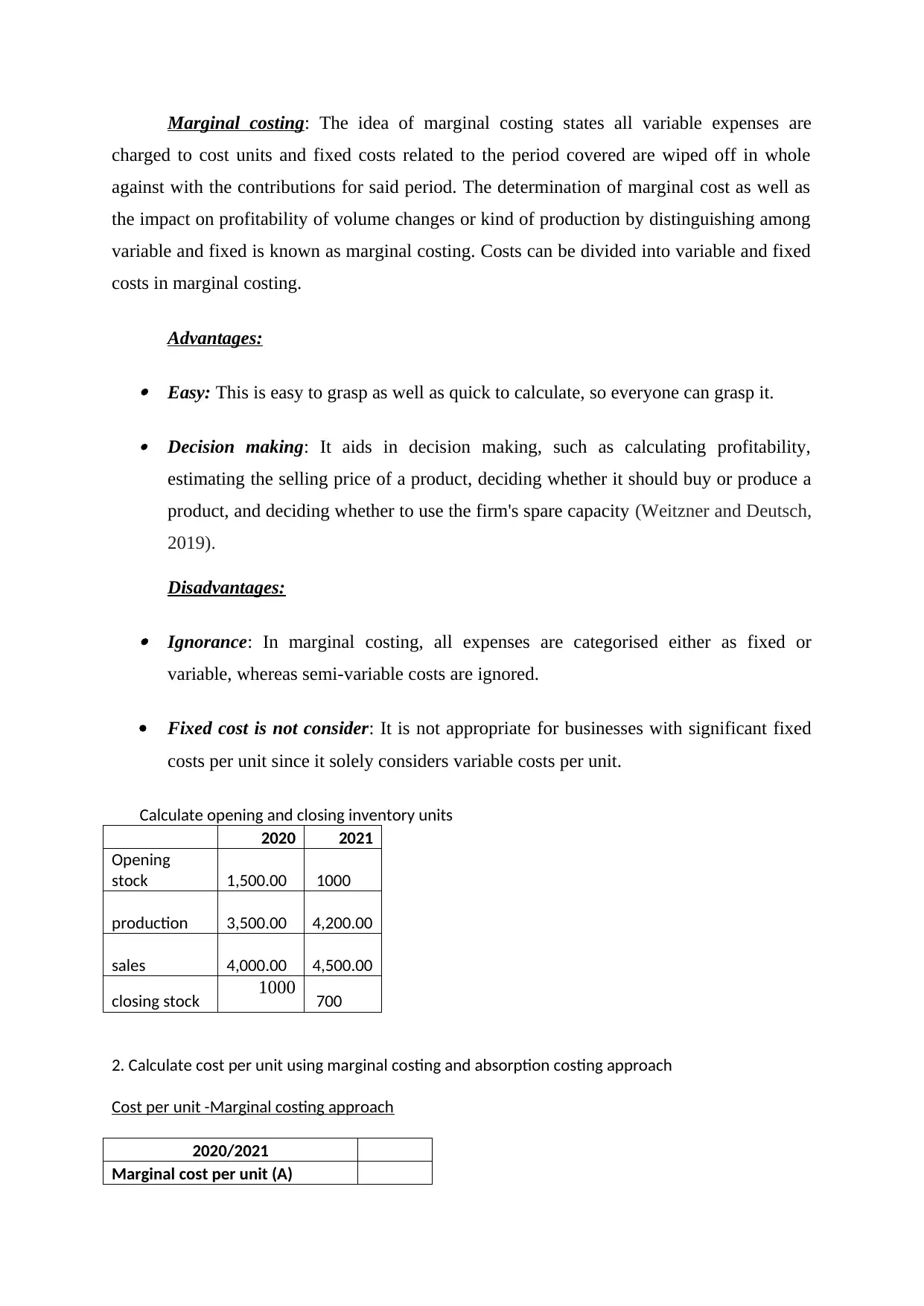
Marginal costing: The idea of marginal costing states all variable expenses are
charged to cost units and fixed costs related to the period covered are wiped off in whole
against with the contributions for said period. The determination of marginal cost as well as
the impact on profitability of volume changes or kind of production by distinguishing among
variable and fixed is known as marginal costing. Costs can be divided into variable and fixed
costs in marginal costing.
Advantages:
Easy: This is easy to grasp as well as quick to calculate, so everyone can grasp it.
Decision making: It aids in decision making, such as calculating profitability,
estimating the selling price of a product, deciding whether it should buy or produce a
product, and deciding whether to use the firm's spare capacity (Weitzner and Deutsch,
2019).
Disadvantages:
Ignorance: In marginal costing, all expenses are categorised either as fixed or
variable, whereas semi-variable costs are ignored.
Fixed cost is not consider: It is not appropriate for businesses with significant fixed
costs per unit since it solely considers variable costs per unit.
Calculate opening and closing inventory units
2020 2021
Opening
stock 1,500.00 1000
production 3,500.00 4,200.00
sales 4,000.00 4,500.00
closing stock 1000 700
2. Calculate cost per unit using marginal costing and absorption costing approach
Cost per unit -Marginal costing approach
2020/2021
Marginal cost per unit (A)
charged to cost units and fixed costs related to the period covered are wiped off in whole
against with the contributions for said period. The determination of marginal cost as well as
the impact on profitability of volume changes or kind of production by distinguishing among
variable and fixed is known as marginal costing. Costs can be divided into variable and fixed
costs in marginal costing.
Advantages:
Easy: This is easy to grasp as well as quick to calculate, so everyone can grasp it.
Decision making: It aids in decision making, such as calculating profitability,
estimating the selling price of a product, deciding whether it should buy or produce a
product, and deciding whether to use the firm's spare capacity (Weitzner and Deutsch,
2019).
Disadvantages:
Ignorance: In marginal costing, all expenses are categorised either as fixed or
variable, whereas semi-variable costs are ignored.
Fixed cost is not consider: It is not appropriate for businesses with significant fixed
costs per unit since it solely considers variable costs per unit.
Calculate opening and closing inventory units
2020 2021
Opening
stock 1,500.00 1000
production 3,500.00 4,200.00
sales 4,000.00 4,500.00
closing stock 1000 700
2. Calculate cost per unit using marginal costing and absorption costing approach
Cost per unit -Marginal costing approach
2020/2021
Marginal cost per unit (A)
Paraphrase This Document
Need a fresh take? Get an instant paraphrase of this document with our AI Paraphraser
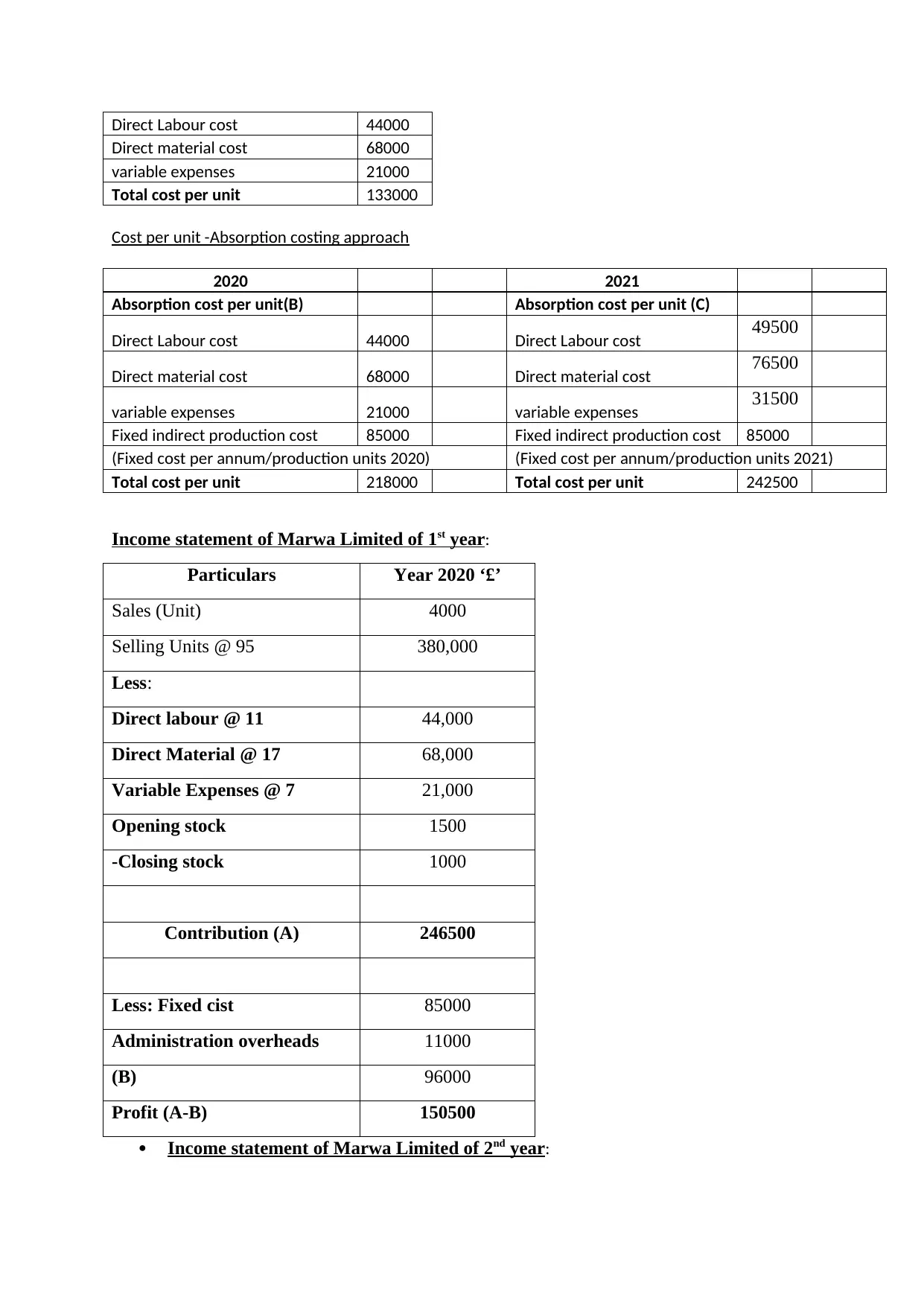
Direct Labour cost 44000
Direct material cost 68000
variable expenses 21000
Total cost per unit 133000
Cost per unit -Absorption costing approach
2020 2021
Absorption cost per unit(B) Absorption cost per unit (C)
Direct Labour cost 44000 Direct Labour cost 49500
Direct material cost 68000 Direct material cost 76500
variable expenses 21000 variable expenses 31500
Fixed indirect production cost 85000 Fixed indirect production cost 85000
(Fixed cost per annum/production units 2020) (Fixed cost per annum/production units 2021)
Total cost per unit 218000 Total cost per unit 242500
Income statement of Marwa Limited of 1st year:
Particulars Year 2020 ‘£’
Sales (Unit) 4000
Selling Units @ 95 380,000
Less:
Direct labour @ 11 44,000
Direct Material @ 17 68,000
Variable Expenses @ 7 21,000
Opening stock 1500
-Closing stock 1000
Contribution (A) 246500
Less: Fixed cist 85000
Administration overheads 11000
(B) 96000
Profit (A-B) 150500
Income statement of Marwa Limited of 2nd year:
Direct material cost 68000
variable expenses 21000
Total cost per unit 133000
Cost per unit -Absorption costing approach
2020 2021
Absorption cost per unit(B) Absorption cost per unit (C)
Direct Labour cost 44000 Direct Labour cost 49500
Direct material cost 68000 Direct material cost 76500
variable expenses 21000 variable expenses 31500
Fixed indirect production cost 85000 Fixed indirect production cost 85000
(Fixed cost per annum/production units 2020) (Fixed cost per annum/production units 2021)
Total cost per unit 218000 Total cost per unit 242500
Income statement of Marwa Limited of 1st year:
Particulars Year 2020 ‘£’
Sales (Unit) 4000
Selling Units @ 95 380,000
Less:
Direct labour @ 11 44,000
Direct Material @ 17 68,000
Variable Expenses @ 7 21,000
Opening stock 1500
-Closing stock 1000
Contribution (A) 246500
Less: Fixed cist 85000
Administration overheads 11000
(B) 96000
Profit (A-B) 150500
Income statement of Marwa Limited of 2nd year:
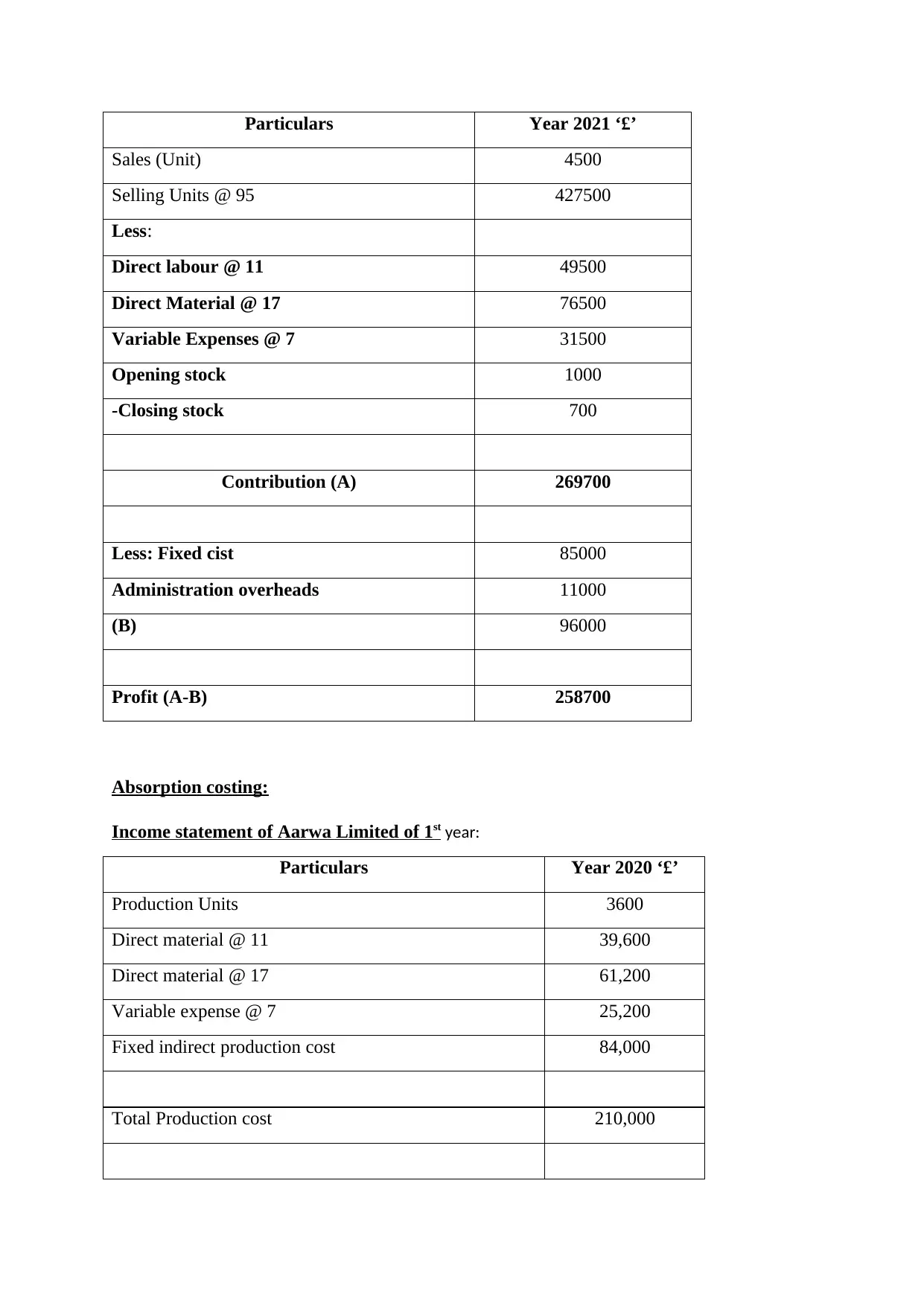
Particulars Year 2021 ‘£’
Sales (Unit) 4500
Selling Units @ 95 427500
Less:
Direct labour @ 11 49500
Direct Material @ 17 76500
Variable Expenses @ 7 31500
Opening stock 1000
-Closing stock 700
Contribution (A) 269700
Less: Fixed cist 85000
Administration overheads 11000
(B) 96000
Profit (A-B) 258700
Absorption costing:
Income statement of Aarwa Limited of 1st year:
Particulars Year 2020 ‘£’
Production Units 3600
Direct material @ 11 39,600
Direct material @ 17 61,200
Variable expense @ 7 25,200
Fixed indirect production cost 84,000
Total Production cost 210,000
Sales (Unit) 4500
Selling Units @ 95 427500
Less:
Direct labour @ 11 49500
Direct Material @ 17 76500
Variable Expenses @ 7 31500
Opening stock 1000
-Closing stock 700
Contribution (A) 269700
Less: Fixed cist 85000
Administration overheads 11000
(B) 96000
Profit (A-B) 258700
Absorption costing:
Income statement of Aarwa Limited of 1st year:
Particulars Year 2020 ‘£’
Production Units 3600
Direct material @ 11 39,600
Direct material @ 17 61,200
Variable expense @ 7 25,200
Fixed indirect production cost 84,000
Total Production cost 210,000
⊘ This is a preview!⊘
Do you want full access?
Subscribe today to unlock all pages.

Trusted by 1+ million students worldwide
1 out of 21
Related Documents
Your All-in-One AI-Powered Toolkit for Academic Success.
+13062052269
info@desklib.com
Available 24*7 on WhatsApp / Email
![[object Object]](/_next/static/media/star-bottom.7253800d.svg)
Unlock your academic potential
Copyright © 2020–2025 A2Z Services. All Rights Reserved. Developed and managed by ZUCOL.





